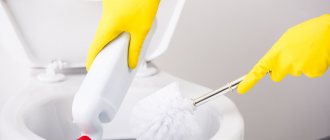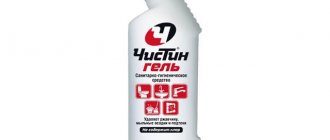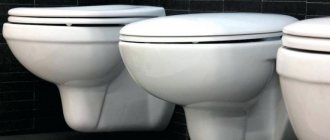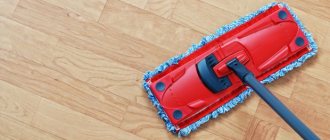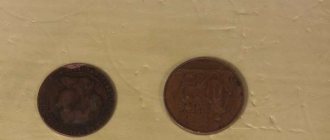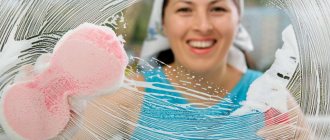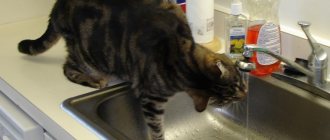There is an opinion that a clean sink and a clean toilet are the face of the housewife, but in fact, not only the reputation of the woman caring for it, but also the health of the household depends on cleanliness. The toilet is a place where pathogenic bacteria constantly accumulate, and the presence of limescale and urinary stone in the drain pipes contributes to this.
There is an opinion that a clean sink and a clean toilet are the face of the housewife, but in fact, not only the reputation of the woman caring for it, but also the health of the household depends on cleanliness. The toilet is a place where pathogenic bacteria constantly accumulate, and the presence of limescale and urinary stone in the drain pipes contributes to this.
Reasons for the appearance of urinary stones on the walls of the toilet
The appearance of urinary stones depends on many factors. The reason may be poor quality of water in the tank, infrequent flushing while using the toilet, a broken tank, old plumbing and poor enamel coating of the drain, or all these reasons together.
Urine stone is a plaque consisting of calcareous and mineral deposits. To a greater extent, the amount of these deposits will depend on the regularity of cleaning the plumbing and on the condition of the pipes; the more rough places there are in the drain pipe, the easier it will be for mineral deposits to settle there, and the thicker the layer of stone will be.
How to clean a toilet from urinary stones
To clean the toilet from corrosive plaque, you first need to remove all existing water from the drain pipe, to do this you need to shut off the access to water and remove the existing water, this can be done using an old ladle, or a jar, a large syringe, a plunger or any other container that can be used you can remove excess liquid from the drain hole.
The presence of water will reduce the effectiveness of stone removal products, so for maximum effect, it is worth fiddling around a little to get the desired result.
Then, carefully protecting your hands from aggressive agents, you need to apply them to the urinary stone, leaving it for a long time, ideally overnight. After some time, the stone is removed with a hard sponge, brush, brush, spatula, possibly a plastic knife or knife, or other thing with a fairly hard surface. However, it is worth considering that by injuring the surface of the drain, the problem with urinary stones will begin to form more often.
Brands of special solutions
Nowadays it’s very easy to go to the store and buy a ready-made product that is not inferior in terms of effectiveness to traditional methods.
Pay attention to these brands:
- BREF - Hungary.
- SC JOHNSON – USA.
- FABERLIC – Russia.
- COMET - USA.
- BAGI - Israel.
- GRASS – Russia.
Folk remedies
The choice of means to combat stone plaque is quite large; you can use a special solution or gel purchased in the store, or you can choose a remedy from the substances available at home.
What can I use to clear stone from a pipe drain?
Vinegar
Vinegar is found in almost every home; its use is not limited to culinary needs. The scope of its application is quite wide and one of such applications is cleaning the toilet.
In order to clean the toilet drain pipe of plaque, you will need vinegar, about a glass and old rags. It is advisable to heat the vinegar, although you can use a solution at room temperature. Then, after putting on gloves, we generously soak old rags with heated vinegar and place them on the affected areas of the drain. The toilet is closed with a lid and left for a while. The plaque softens under the influence of vinegar and is easily separated from the surface with a spatula or knife.
7 effective ways to clean a clogged toilet
Lemon acid
Citric acid powder has long established itself as an excellent tool for removing various scales and lime deposits. Therefore, when choosing this remedy to combat urinary stones, the result will not be long in coming.
Citric acid should be applied with a damp sponge or rag in a thick layer to the affected areas, left for several hours, and then stung with a hard sponge or brush. Sometimes the procedure should be repeated until the plaque is completely eliminated.
Oxalic acid
The principle of working with oxalic acid is the same as when working with citric acid. Oxalic acid crystals are applied to a damp surface in a thick layer and left for some time, then the surface is cleaned with a hard sponge.
You should take into account the fact that oxalic acid is very caustic and you must use gloves when working with it!
Baking and soda ash
Baking soda and soda ash can be used to clean the drain pipe either in its pure form or in combination with acetic acid, and some housewives also use chlorine bleach.
If you choose chlorine for cleaning the toilet, you should take care to protect your lungs from the release of caustic gas; for these purposes, you should take care of good ventilation of the toilet room and the ability to close the toilet tightly.
Baking soda, in relation to soda ash, is converted with water into a thick paste, which is applied to damaged surfaces. If desired, after some time the soda slurry is sprayed on top with vinegar and/or chlorine bleach. Then, using a stiff brush, the mixture is removed along with the plaque. If necessary, the procedure should be repeated.
Coca-Cola or Sprite
Due to the fact that imported soda contains a large amount of citric acid, it is often used to remove various deposits and scales. Coca-Cola has also proven itself in cleaning toilets.
This tasty and not the cheapest method is quite effective; if necessary, the soda can even be heated. The effect occurs in approximately 3-4 hours.
White
Whiteness contains in its composition a caustic ingredient that effectively removes lime deposits, while it dissolves it entirely. The effect of whiteness can be compared with the effect known to many housewives, Domestos.
Bleaching
One of the healthiest ways to remove stone deposits is to use chlorine. Working with this product requires special care, since if handled improperly, you can get a burn to the respiratory tract. Due to its properties, which allow not only to remove plaque, but also to kill all possible microbes, bleach still remains one of the most common means used for cleaning toilets.
Salt and vinegar for cleaning the toilet
These substances are suitable for those people who want not only to get rid of stones, but also to have an antibacterial effect. The antiseptic here is salt, which fights harmful bacteria well.
The process looks like this:
- Preparation of vinegar and equipment. Here, too, it is necessary to heat the substance until it reaches a temperature of forty-five degrees.
- Add one to two teaspoons of salt.
- Apply the resulting liquid to problem areas.
- At the end of spraying, wait until it softens completely, then simply rinse off the water.
This procedure looks quite simple, the materials can also be found in any home. That is why it is not inferior in popularity to the previous ones.
Store products
Modern household chemicals allow you to quickly and effectively eliminate any problem, including eliminating limescale that has formed in the toilet.
How to make a toilet snow-white and remove rust stains
Domestos
This tool has already been mentioned above. Domestos dissolves limescale in the drain pipe, softens it and makes it easy to eliminate the problem. The product usually has a gel structure and does not drain from the surface immediately, which allows you to exclude additional elements, such as old rags, when using it. Contains chlorine!
Dressing Duckling
Another remedy for fighting plaque and bacteria is toilet duck. Its main component is hydrochloric acid. The method of application is the same. You need to apply a thin layer of the product to the damaged areas and leave for a while, repeat if necessary. Then clean the drain with a stiff brush or sponge and rinse with plenty of water.
Cillit
The composition of this product also contains hydrochloric acid. According to users, it has proven itself to be excellent in cleaning toilet bowls from limescale build-up.
Comet
Another modern means of combating bacteria and limescale deposits under the toilet rim and in the drain holes. The product has proven itself in the fight against limescale and rust. Directions for use: Apply the product to damaged areas, leave for 15-20 minutes and then remove with a brush or hard sponge.
Sanox
Cleaning product produced by Aist. It has an affordable price and a quick cleaning effect.
Mister Muscle
To remove limescale deposits in the toilet bowl, you should choose Mister Muscle in granules. The crystals are applied to the damp damaged surface, which is subsequently cleaned with a brush and washed with water.
Antikalk
A specially developed product for removing limescale from plumbing fixtures. Use according to instructions.
Potent chemistry
If the dirt is very old and the layer of limescale is very thick, then strong substances come into play.
Please note that their frequent use is contraindicated!
Hydrochloric acid
The use of hydrochloric acid requires compliance with safety rules. It is not recommended to inhale acid vapors! The use of acid in the presence of plastic pipes is prohibited. The use of protective gloves is mandatory!
The acid is applied to the inner surface of the toilet and under the rim, left for 15 minutes and washed off with a brush and a large stream of water.
Battery electrolyte
The main component of battery electrolyte, which is the main active element in a car battery, is sulfuric acid. It is known from school curriculum that this substance is extremely dangerous and must be used with extreme caution and only in the most extreme cases.
Orthophosphoric acid
This substance will allow you to get rid of urinary stones in just 10-15 minutes. It can be used even in the presence of plastic elements and pipes. Be sure to use rubber gloves!
Let's sum it up
When choosing a toilet care composition, it is necessary to take into account not only the material of the plumbing fixtures, but also the pipes - for example, plastic pipes “will not forgive” the use of aggressive acids. In addition, you should not wash the structure too often with chemical components, if you can get by with traditional ones - this way you will preserve the glossy surface for a long time.
Finishing the toilet with PVC panels will greatly simplify the improvement of the interior of the toilet. In a special article, we’ll look at how to finish wall panels in a bathroom, and we’ll also figure out how to choose the right material.
How to clean a toilet rim from urinary stones
The principle of cleaning a toilet from plaque under the rim is no different from cleaning a drain pipe, only in this case the cleaning agent is applied directly under the toilet rim. It is better to choose liquid products that can be easily applied under the rim. For example, use household chemicals in convenient plastic containers with a curved spout. You should then use a toilet brush to remove dirt. For rinsing, you can use a powerful syringe.
The toilet is clogged - how to deal with it yourself?
What to do if the toilet is clogged with urinary stones
It happens that urinary stones form on the walls of the drain pipe, in places inaccessible to the human eye. In these cases, residents often encounter periodic blockages.
To eliminate this problem, you can use special tools to remove blockages, which help to corrode not only the blockages themselves, but also the stone that caused them. If clogs occur frequently, it may be worth calling a professional to fix the problem.
Mechanical impact
If there is a too dense layer of stones, you can get rid of it mechanically using a hammer and screwdriver. But you should work carefully so that the tools do not touch the plumbing, because with a strong impact you can not only damage the coating, but also split the structure.
Due to mechanical stress, the toilet may become unusable
Prices for toilets, urinals, bidets
Toilets, urinals, bidets
Features of cleaning toilets made of various materials
When cleaning your toilet, you should consider the materials it is made from. Nowadays, toilets themselves are most often made of ceramics or earthenware, but pipes can be made of different materials, plastic, metal, or both metal and plastic. Pipe connections can be made of plastic or rubber. These nuances should be taken into account when choosing products to remove contaminants.
If the toilet is made of porcelain. When cleaning porcelain toilets, it is important not to damage the enamel with which it is covered; excess scratches on the surface lead to the destruction of the toilet and contribute to the rapid clogging of damaged areas with limescale, and urinary stones form even faster. Here you should avoid cleaning with abrasives and powders. To clean a porcelain toilet, it is best to choose acidic and alkaline cleaners.
Ceramics and faience. When cleaning ceramic and earthenware toilets, a hydrochloric acid solution is ideal. Metal brushes and spatulas should be excluded, as they cause scratches. When treating a toilet bowl, it is not recommended to use boiling water unless you want to replace a burst toilet bowl.
Polymer concrete. For toilets made from polymer concrete, gel and liquid cleaners are well suited.
Stainless steel. The most easy-to-maintain toilets are made from this material, but they are quite rare. When cleaning stainless steel toilets, any cleaning and auxiliary products are suitable. A spatula, iron brushes, all this will not cause any harm to the toilet. You can also use boiling water for processing.
Methods for preventing stone deposits
It is easier to prevent any problem than to fix it. To make urinary stones less likely to be deposited, you should follow some rules.
Simple ways to keep your toilet clean:
- Clean the toilet regularly, without waiting for rocky deposits to accumulate on its walls.
- Use tablets or gels to soften the water in the tank.
- Replace old plumbing fixtures in a timely manner.
- Avoid standing water in the toilet; if you plan to be away for a long time, pour a small amount of cleaner into the drain pipe.
- Make sure the drain tank is in good working order.
Preventing the formation of contaminants
Once you try to remove traces of old plaque or rust using one of the above methods, you will come to the conclusion that it is better to prevent than to make such efforts.
Especially when you consider that preventive measures are quite simple and require much less time and effort.
- To prevent the formation of limescale, use special tablets for the tank . Their main action is aimed primarily at softening water and neutralizing alkalis. They also tint the water in various shades and give it a pleasant aroma;
- Gel products, which are attached to the rim of the toilet, disinfect the surface with each flush and prevent the formation of urinary stones;
- Make sure that the toilet tank does not leak , otherwise the formation of rust is inevitable;
- If the tank is functioning normally, but rust still forms, it is necessary to replace the old water pipes , otherwise the problem will not go away. If the pipes in the apartment are plastic, it means that corrosion has affected the iron pipes of the central water supply. In this case, only installing a filter will help;
- Once a week, treat the surface of the toilet with chlorine-containing products or regular white. This is both a method of disinfection and elimination of unpleasant odors, and a way to combat the appearance of limescale;
- If the design allows, once a week remove the lid and toilet seat and wash them thoroughly with any detergent and then under hot water;
- Make sure that all family members use the drain , otherwise your efforts will be in vain.
The article was written for the site.
Tags:Cleaning, Toilet
